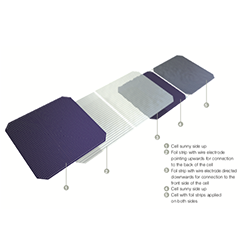While PERC has long since become the standard in the production of solar cells and the first major solar cell producers have already set their sights on the next upgrade technology, meaning TOPCon, a revolutionary technology is now reaching market maturity and promises the ‘solar cell of the future’.
Solar cells with so-called heterojunction technology (HJT) have long been regarded as a premium product. The Swiss production equipment supplier Meyer Burger has invested heavily, with the aim of industrializing the technology for mass production.
The first complete production lines are currently coming into operation in Hungary (Ecosolifer) and Italy (3Sun). At the beginning of the year, scientists from the French research institute, CEA, succeeded in producing heterojunction solar cells with an efficiency of 23.9% on mass production facilities at Meyer Burger. A resulting solar module, with 120 half-cells and SmartWire Connection Technology (SWCTTM), had a measured output of 348 W.
Moreover, in December 2018, Meyer Burger announced the sale of a combined 600 MW production line for HJT cells with SmartWire Connection Technology. The purchaser was anonymous at the time but we now know it to be REC, the Norwegian company which operates a major production base in Singapore. The solar cell of the future has thus arrived.
Heterojunction technology: combining the best of two worlds
Heterojunction technology (HJT) combines the high efficiencies of monocrystalline (c-Si) silicon solar cells with the exceptional passivation properties of amorphous silicon (a-Si), a material already well-known from thin film technology. Both Panasonic and Kaneka have demonstrated the effectiveness of this approach many times in the past.
The current efficiency record (26.63%) was set by Kaneka in August 2017. To achieve this, the Japanese company used an IBC contact for which cost-effective manufacturing methods, suitable for mass production, are only at the development stage.
HJT cells have a relatively simple structure and are fundamentally bifacial by design. Thin intrinsic a-Si layers are applied to a monocrystalline n-type silicon wafer. The production process consists of significantly fewer steps than PERx processes and it takes place at lower temperatures, enabling the use of thinner wafers.




























